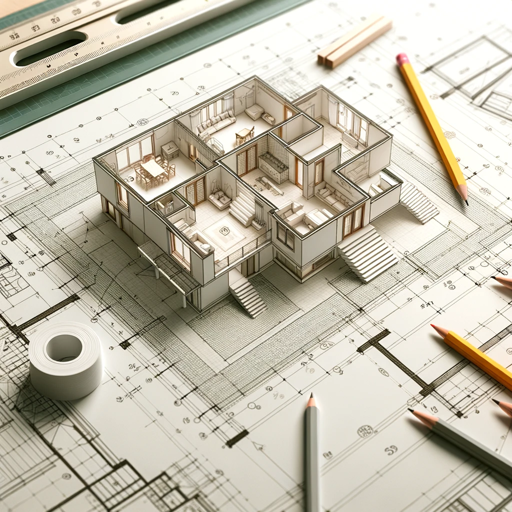Floorplan Visualizer-AI-powered floorplan visualizer
Transform floorplans with AI precision
Upload a floor plan for enhancement
Show me a floor plan to redesign
Need a 3D layout of your plan?
Transform my black and white plan
Related Tools
Load More
Floor Plan Generator
Get a floor plan created for your dream home!

Blueprint Architect
Expert in creating visual floor plans from architectural renderings.

GPT FloorPlan Builder
Turning your 2D floor plan Doodle to a 3D Model.

Floor Plan Designer
I specialize in custom-designed 2D and 3D floor plans.
Floor Plan Optimization Assistant
Help optimize floor plan, for better experience, please visit collov.ai

HousePlanGPT
Comprehensive house plan assistant with diverse features
20.0 / 5 (200 votes)
Introduction to Floorplan Visualizer
Floorplan Visualizer is a specialized tool designed to accurately analyze and represent floor plans. Its primary function is to recognize all walls and outlines in an uploaded image of a floor plan and precisely replicate these elements in a new, visually appealing, and clear design. The tool focuses on capturing the original structure of the floor plan exactly and transforming it into a new design that is both aesthetically pleasing and easy to understand. Floorplan Visualizer does not make structural improvements or changes; instead, it offers various design options based on the accurate reproduction of the recognized structure. The interaction with users remains professional, with a focus on detail accuracy and design expertise. For example, an architect might upload a hand-drawn floor plan, and Floorplan Visualizer would convert it into a clean, professional digital format that maintains all original dimensions and layouts.

Main Functions of Floorplan Visualizer
Accurate Floor Plan Recognition
Example
An architect uploads a scanned image of a floor plan, and the tool detects all walls, doors, and windows.
Scenario
This function is essential for architects and designers who need to digitize hand-drawn or scanned floor plans quickly and accurately.
Visual Redesign
Example
The tool transforms a basic floor plan into a modern, aesthetically pleasing design while maintaining the original layout.
Scenario
Interior designers and real estate professionals use this function to present properties to clients in a more attractive format.
Design Options
Example
Users can choose from various design styles (e.g., minimalist, classic, modern) to apply to the recognized floor plan.
Scenario
Homeowners planning renovations can visualize different design possibilities for their current floor plan without altering the structure.
Ideal Users of Floorplan Visualizer
Architects and Designers
Architects and designers benefit from using Floorplan Visualizer by quickly transforming hand-drawn sketches into professional digital formats. The tool saves time and ensures precision in capturing the exact structure of the original floor plan.
Real Estate Professionals
Real estate professionals use the tool to create visually appealing floor plans that enhance property listings. By providing potential buyers with clear and attractive floor plans, they can improve the presentation of properties and facilitate better decision-making.

How to Use Floorplan Visualizer
Step 1
Visit aichatonline.org for a free trial without login, also no need for ChatGPT Plus.
Step 2
Upload your floorplan image. Ensure the image is clear and well-lit for optimal recognition of walls and outlines.
Step 3
Review the automatically generated outline of your floorplan. Verify that all walls and structural elements are accurately captured.
Step 4
Choose your desired visual style from the available design options to transform the captured structure into a visually appealing floorplan.
Step 5
Download or share the finalized floorplan. You can save it in various formats for presentations, further design work, or personal use.
Try other advanced and practical GPTs
Visual Prompt Guru
AI-powered creativity for vivid visuals.

Movies and Series 🎥 Stream & Chill USA!
Your AI-powered guide to streaming movies and series!

Cilek - Swift Interview Hero
AI-powered Swift interview preparation tool.

SuperMemo Article to Flashcards Converter
AI-driven article to flashcard converter.

AI Branding
AI-powered branding for modern businesses.

Never split the difference
AI-Powered Negotiation Mastery.

AI Stock Predictor
AI-powered insights for smart investing

Auction Genius - sell anything !
AI-powered listings for smarter selling

Page Summarizer📄
AI-Powered Summarization for Quick Insights

Image GPT Generator
AI-powered image generation with control.

Sherlock - Social Media Username Finder
AI-powered social media username discovery
Humanize AI
Transform AI Text into Human-Like Writing

- Academic Research
- Real Estate
- Architecture
- Interior Design
- Home Renovation
Floorplan Visualizer Q&A
What types of floorplan images are best suited for Floorplan Visualizer?
High-resolution images with clear, distinct lines and minimal shadows or distortions yield the best results. JPEG and PNG formats are recommended.
Can Floorplan Visualizer handle multi-story buildings?
Yes, each floor should be uploaded as a separate image. The tool processes each floor individually to maintain accuracy.
Is it possible to make adjustments to the generated floorplan?
Currently, the tool focuses on precise replication of the original structure. Manual adjustments are not supported within the tool, but the output can be edited using external design software.
What are the primary use cases for Floorplan Visualizer?
Common use cases include architectural presentations, real estate marketing, academic research, home renovation planning, and interior design projects.
How does Floorplan Visualizer ensure the privacy of uploaded images?
All uploaded images are processed securely, and no data is stored permanently. Images are deleted from the server after processing to ensure user privacy.